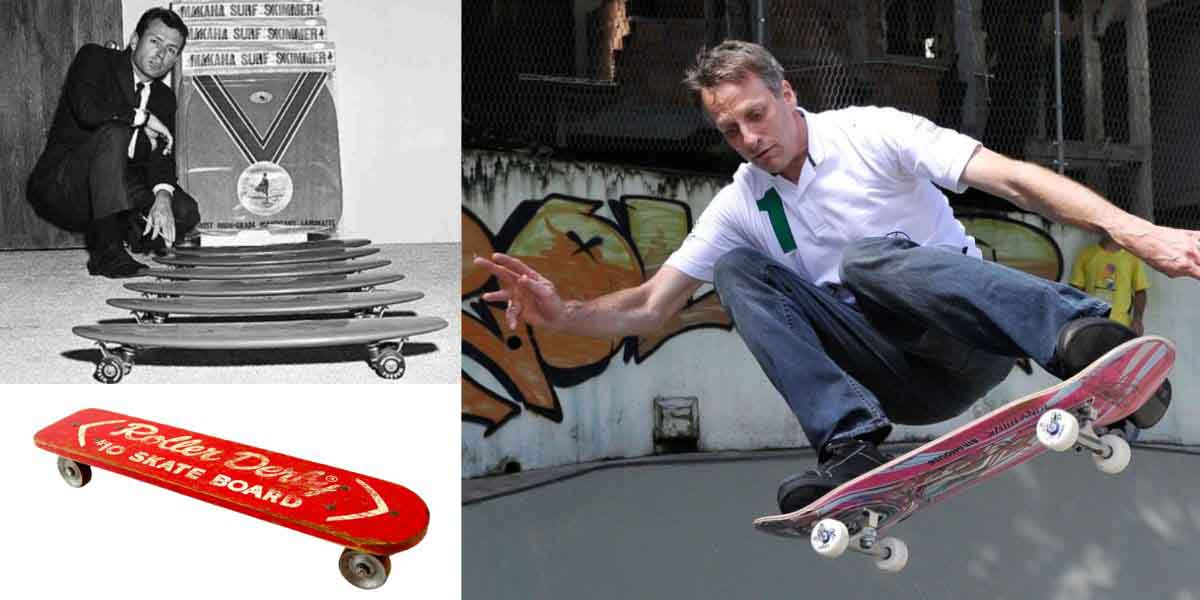Skateboarding is a popular sport and hobby enjoyed by many. But have you ever wondered who is the inventor of the skateboard? While it’s hard to pinpoint a single inventor, key figures like Bill Richard and Larry Stevenson made significant contributions. In this article, we will describe the history and evolution of the skateboard. We will also cover everything from its beginning to the modern-day phenomenon it has become.
Early Beginnings
The origins of the skateboard date back to the late 1940s and early 1950s. This was a time when surfing was incredibly popular in California. Surfers, always looking for new ways to ride, came up with the idea of “sidewalk surfing” for those days when the ocean waves were flat.
The First Skateboards
The first skateboards were rudimentary. Creative surfers took old wooden planks and attached roller skate wheels to them. These early versions could have been better and often unstable. However, they marked the beginning of something extraordinary.

Who Invented the Skateboard? Key Contributors
While skateboarding’s exact origin is hard to pinpoint. However, two individuals are often credited with significant contributions to the development of the skateboard: Bill Richard and Larry Stevenson.
Bill Richard
In 1958, Bill Richard partnered with the Chicago Roller Skate Company to create a skateboard with clay wheels. This was a groundbreaking development at the time. The clay wheels provided a smoother ride compared to the metal wheels used before. This innovation made skateboarding more appealing and accessible to a broader audience.
Larry Stevenson
Larry Stevenson, a surfer and lifeguard from California, made another significant contribution in 1963. He invented the “kicktail,” the upward bend at the end of the skateboard. The kicktail revolutionized skateboarding. It allowed riders to perform tricks and maneuvers that were previously impossible. Stevenson’s invention was crucial in transforming skateboarding from a simple pastime into a complex and exciting sport.

The Evolution of Skateboarding
With the invention of the kicktail, skateboarding quickly evolved. By the mid-1960s, skateboarding had become a full-fledged craze. Skateparks began to spring up, and the first skateboarding competitions were held. Skateboarding magazines like “Skateboarder,” were launched. These publications further fueled the sport’s popularity.
The Rise and Fall of Skateboarding in the 1970s
The 1970s were a tumultuous time for skateboarding. The sport experienced a boom in popularity, followed by a sharp decline. Several factors contributed to this. On the one hand, the introduction of polyurethane wheels made skateboarding smoother and more enjoyable. On the other hand, concerns about safety and the closure of many skateparks led to a drop in interest.
Skateboarding in the 1980s
The 1980s saw a resurgence in skateboarding’s popularity. This was largely due to the efforts of a new generation of skateboarders who pushed the sport to new heights. Skateboarding legends like Tony Hawk and Rodney Mullen emerged, showcasing incredible tricks and techniques. The introduction of the ollie, a trick invented by Alan “Ollie” Gelfand, revolutionized street skating.
The Modern Era of Skateboarding
Today, skateboarding is very popular. It is a global sport with millions of fans. Skateboarding has grown with new tricks, styles, and events. It will even be in the Olympics, showing it is a respected sport.
The Influence of Skateboarding on Culture
Skateboarding affects more than just the sport. It has a big impact on music, fashion, and art. Skaters have a unique style that mixes practicality with creativity. Skateboarding videos and movies help spread the culture and inspire new skaters.
Notable Figures in Skateboarding History
Bill Richard and Larry Stevenson are credited with key innovations in skateboarding. Many other individuals have also contributed to its growth and evolution. Here are a few notable figures:
- Tony Alva: One of the original Z-Boys, Tony Alva was instrumental in the development of vertical skateboarding.
- Stacy Peralta: Another member of the Z-Boys, Stacy Peralta went on to become a filmmaker and document the history of skateboarding.
- Tony Hawk: Known for his incredible skills and numerous contributions to the sport. Tony Hawk is one of the most famous skateboarders of all time.
- Rodney Mullen: Often called the “Godfather of Street Skating,” Rodney Mullen invented many of the tricks that are now staples in street skating.
The Future of Skateboarding
The future of skateboarding looks bright. With its inclusion in the Olympics, skateboarding has gained even more recognition. The continued growth of skateparks and skateboarding communities around the world shows that the sport is not slowing down. Innovations in skateboard technology and design continue to push the boundaries of what is possible.
FAQs About the Inventor of the Skateboard
Who invented the skateboard?
The skateboard’s invention is attributed to surfers in the 1940s and 1950s, with significant innovations by Bill Richard and Larry Stevenson.
What was the first skateboard made of?
The first skateboards were made by attaching roller skate wheels to wooden planks.
What is a kicktail?
A kicktail is an upward bend at the end of the skateboard. It was invented by Larry Stevenson in 1963 and allows skaters to perform tricks.
How did polyurethane wheels impact skateboarding?
Polyurethane wheels, introduced in the 1970s, made skateboarding smoother and more enjoyable. This innovation contributed to a boom in the sport’s popularity.
Who are some notable figures in skateboarding history?
Notable figures include Tony Alva, Stacy Peralta, Tony Hawk, and Rodney Mullen, each contributing significantly to the sport’s development.
Conclusion
The question of who invented the skateboard sparks curiosity and debate. It’s hard to credit just one person. Bill Richard and Larry Stevenson played crucial roles in its development. Their contributions helped shape skateboarding into the exciting sport it is today. From its humble beginnings as a pastime for surfers, skateboarding has grown into a global phenomenon. It has left a significant mark on culture, fashion, and art. With its bright future, skateboarding continues to inspire and thrill people around the world.

